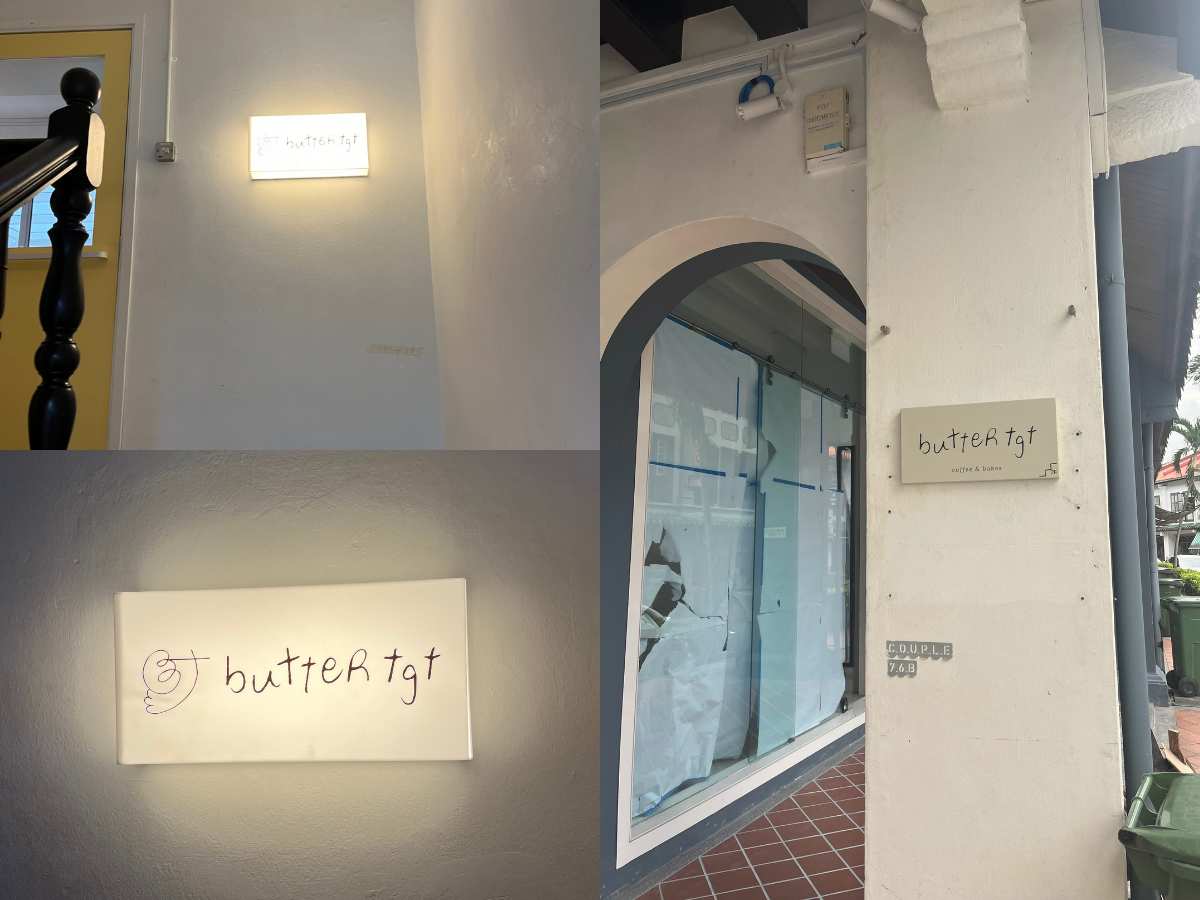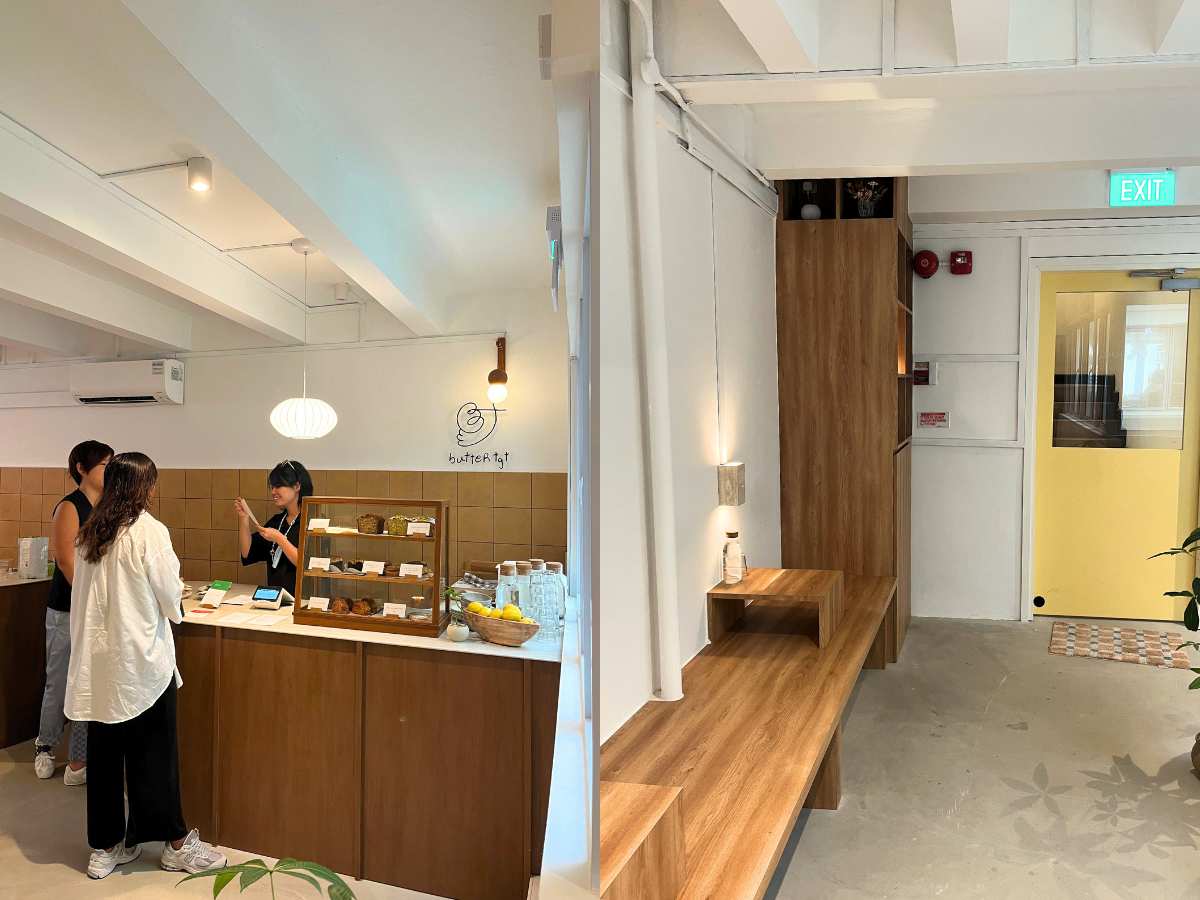Butter Tgt: Popular home-baker opens first brick-and-mortar store at Duxton

If you’ve been to Duxton Hill, you might be familiar with the row of compact shophouses and nondescript stairways, often leading to hidden gems on the second floor.
At times, it might feel like you’re entering a secret hideaway that only you know about. Visiting Butter Tgt felt exactly like that.

I must’ve walked up and down, past the stairway entrance, at least three times, before a staff member from a neighbouring bistro directed me to Butter Tgt.
Nestled behind a nondescript swing door — one that resembled a “staff-only” type entrance — the cafe was marked only by a simple sign and stairway.

In spite of some construction works in its neighbouring unit during my visit, Butter Tgt was a much-needed calm and serene spot, somewhere away from the hustle and bustle of city life.
The cafe is warm and inviting, decorated with minimalism in mind. Its low ceiling and hanging pendant lights, oak furniture and pops of muted yellow only added to its charm.
The menu at Butter Tgt

Butter Tgt is helmed by Ng Yu Feng, the baker behind popular home-based business, @youkneadcakes on Instagram. This is its first brick-and-mortar space after the brand’s stint at Baker X — an incubation space at Orchard Central — earlier in May.
A quick search on Yu Feng’s Instagram page will show you her madeleines taking centre stage in every order. Naturally, we had to try them in-store.

Butter Tgt’s madeleines (S$7.50) come in a set of three and are baked to order — a recipe which Yu Feng has been tweaking ever since she started baking during the Covid-19 pandemic.
Easily the favourite item we ordered, the madeleines have a crispy outer layer with a soft and fluffy sponge on the inside. Each bite was filled with fresh, buttery goodness and we couldn’t get enough of it!
If you — like me — appreciate the contrast between the crisp exterior and soft, fluffy insides, you’ll enjoy Butter Tgt’s madeleines for sure. (It’s best when it’s fresh and warm!)
Related Articles:

If you’re looking for more savoury options, try the sourdough toast (S$8), which comes with a dollop of housemade kombu miso butter.
For something with a bit more heft, you can go instead for the avocado toast (S$12), which sees a generous portion of sliced avocados heaped atop the sourdough and some garlic butter.
We especially liked the housemade butters, both of which were creamy, full of umami and complemented the sourdough bread well.
The garlic butter was not overpowering, rather, it was fragrant and light on the palate, with a light saltiness that cut through the creaminess of the avocado.
My only gripe was that the avocado was too firm for my liking, which meant there was a slight chew to it.
You could also go for its grilled peanut butter banana toast (S$10), which comes with its housemade peanut butter.

For those who want a nice cuppa to enjoy your book with, you’ll enjoy Butter Tgt’s reliable coffee menu. We got its iced dirty matcha (S$8) and its iced coconut americano (S$7.50) — drinks to please our need for aesthetics (and palates).
The iced dirty matcha was well-balanced and thankfully lacked any matcha bitterness, while the iced coconut americano was pleasantly refreshing and came with delightful bits of coconut.

If you’re looking for a place to enjoy a peaceful brunch with simple menu items, Butter Tgt will be your hideaway along the popular Duxton Hill stretch (Rappu, Sago House, Nook, anyone?).
We’d recommend that you go in a little later in the afternoon to beat the brunch crowd, though.
For the latest eats, read about the newly opened June Cafe, or check out the retro concept Toast Box at Takashimaya. Alternatively, check out the newest openings in Singapore here.
Do explore the GrabFood Dine Out service for awesome deals.
You can also book a ride to Butter Tgt to check out the new cafe.
Butter Tgt
76A Duxton Road
Nearest MRT station: Tanjong Pagar
Open: Wednesday to Monday (8.30am to 5pm)
76A Duxton Road
Nearest MRT station: Tanjong Pagar
Open: Wednesday to Monday (8.30am to 5pm)







